
The second edition of the Kingston Invitational was held from Monday 24 to Friday 28 July 2023 at Kingston University, genial hosts of the 2022 tournament. The event included two groups of 10, and master norms were on offer in the first group. The fields (in current Fide rating order) for the two sections are shown below.
Norm tournament
- IM Conor Murphy
- IM Graeme Buckley
- CM Vladimir Li
- IM Chris Baker
- CM David Maycock
- IM Peter Large
- IM Andrew Muir
- FM Roland Bezuidenhout
- CM Ranesh Ratnesan
- CM Peter Lalić

Fide all-play-all
- Daniel Johnson
- CM Mark Josse
- Alistair Hill
- Stefan Bergsson
- Michael W Healey
- CM Rob Willmoth
- Tim Seymour
- Phil Makepeace
- WCM Zoe Varney
- Will Taylor

Playing conditions
Dates: Monday 24 July to Friday 28 July.
Venue: Room 2012 in the John Galsworthy Building, Penrhyn Road campus, Kingston University.
Start times: Nine rounds, starting at 10am and 3.30pm. There will be one round on Monday – starting at 3.30 in the afternoon – and two on Tuesday, Wednesday, Thursday and Friday.
Pairings: These will be issued by tournament controller Lance Leslie-Smith a couple of weeks ahead of the event and shown on the Chess Results server.
Time control: 90 minutes + 30 seconds a move.
Prize money in each group: £250 for first; £100 for second; £50 for third + £50 best game prize.
Tie-breakers in each group: Prize money will be shared if players are on the same points score, but the trophy for each section will be awarded on the basis of head-to-head encounter and then performance rating across the tournament.
Spectators: We welcome spectators, though given that the room is not huge we reserve the right to limit the flow if it becomes very busy.
Live games: Games from the norm tournament will be broadcast live on chess.com and Lichess. Games from the all-play-all will be shown as PGNs on the Chess Results server. PGNs of the games in the norm tournament will also appear on the Chess Results server.
Day 1: Monday 24 July
The Kingston Invitational norm tournament got off to a positive start at Kingston University with three decisive games out of five in round 1. Even before round 1 began there was (metaphorical) blood on the board as IMs Peter Large and Graeme Buckley met to play their round 4 game in advance as Peter is unavailable to attend on Wednesday morning. Large, playing Black, got the better of his opponent and ground out a rook ending to go plus one in advance of the afternoon’s games.
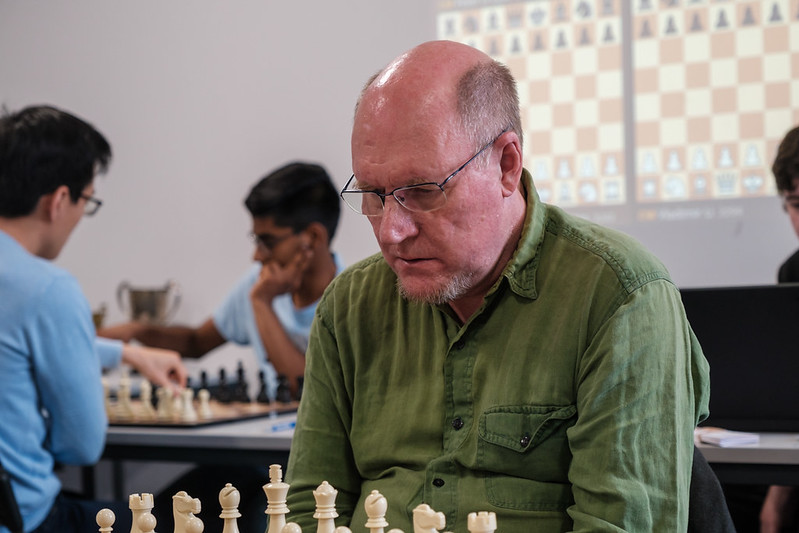
In the afternoon, Kingston player Vladimir Li was the first to show his mettle by defeating teenager Ranesh Ratnesan. The opening was a c3 Sicilian, which is usually regarded as one of the quieter lines of this combative defence. The queens were soon removed, but Li sprang a positional surprise by launching his king up the board in the middlegame to attack an enemy pawn. It looked risky, but was validated by later analysis with the Stockfish engine. White soon got the better of a tactical melee, and after that Black never got a look in as White’s bishop pair ruled the board.
At one stage of his game against IM Chris Baker, Peter Large looked set to claim his second IM scalp of the day as he forced open the e-file to attack his opponent’s king. Black had to give up a piece to stay in the game, but no sooner had Large established a won position than he blundered and had to give it back to extract his queen from a trap. A level rook-and-pawns ending ensued. After the rooks were exchanged, there followed a rather more tricky king-and-pawn ending. Momentarily, White went wrong and was technically lost for one move, but it would have required a silicon brain to exploit the fleeting chance. Instead, a draw was the result.
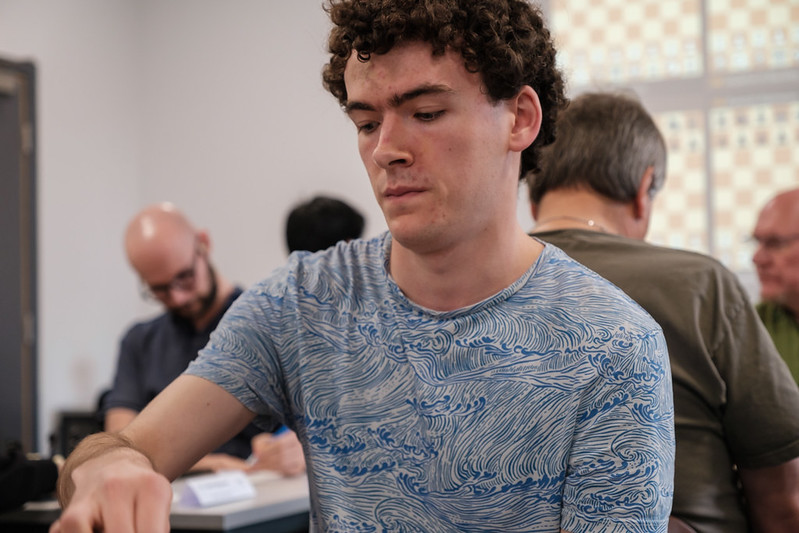
Conor Murphy versus Andrew Muir was a Sicilian Richter and promised much, with the players attacking on opposite sides of the board. However, it never quite caught fire and ended with a repetition on move 26.
The game between Kingston teammates David Maycock and Peter Lalić began with a Scandinavian Defence, or rather a gambit as Black chose to play 2…c6 rather than recapture on d5. It soon became very unclear as Black hurled his queen at Maycock’s king and gave up a second pawn. But it all went desperately wrong for Black, though engines indicate he could have got considerable compensation for the pawns around move 15.
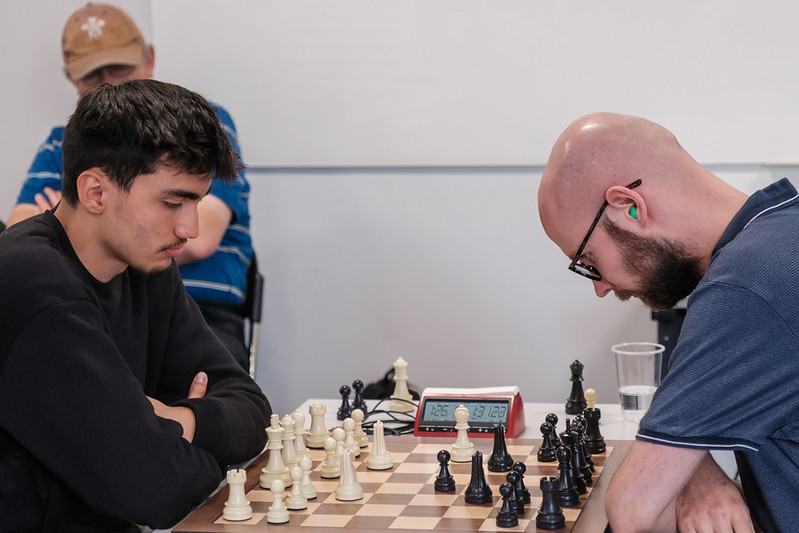
The game between Graeme Buckley and Roland Bezuidenhout began with a French Defence, Milner-Barry Gambit, with its typical wall of pawns across the board preventing the engagement of the rest of the pieces. However, Buckley, enterprising as always, chose to breach the wall with a pawn sacrifice on move 26, much to the disapproval of Stockfish. A real slugging match ensued over the following 30 moves, until Black, two pawns up in a queen-and-rook endgame, made a misstep and was lost.
The welcome spirit of fighting chess was also on show in the 10-player Fide all-play-all, which is being played in tandem with the norm tournament and in the same room at Kingston University. Again there were three positive results, and the all-play-all promises to have just as much drama as the norm event.
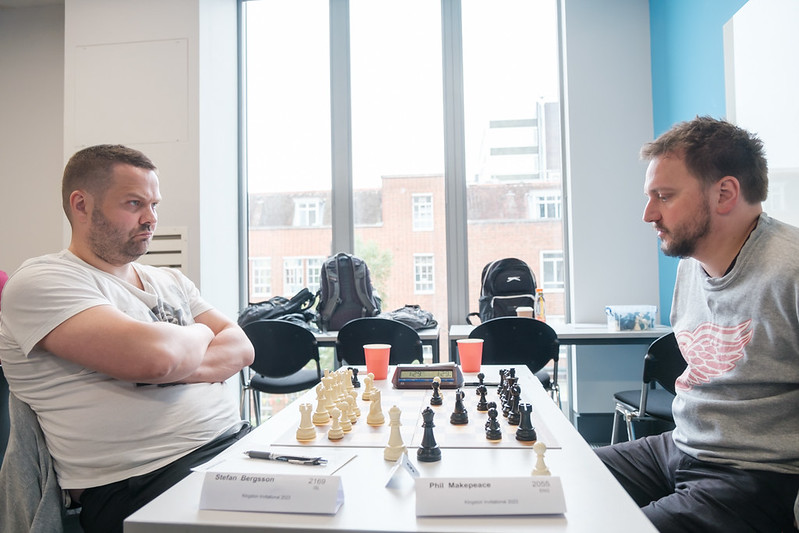
The Icelandic player Stefan Bergsson – fresh off the plane – got the better of a rook-and-pawn endgame against Phil Makepeace. Mike Healey enjoyed an impressive win against Sweden’s Daniel Johnson, the highest rated player in the section, going the exchange up and using his advantage to mop up pawns and force resignation. And Surbiton 4NCL captain Tim Seymour won a fine game against Kingston’s Will Taylor, blowing open Will’s kingside with his queen and rook.

WCM Zoe Varney enjoyed a solid start to the tournament, drawing with Black against Alistair Hill, and experienced CMs Mark Josse and Robert Willmoth had a hard-fought draw to complete the round. Four days of tough chess now lie ahead, with two games a day. We will all need to pace ourselves.
John Saunders
Day 2: Tuesday 25 July
After the metaphorical bloodletting of round 1, the Kingston Invitational norm tournament took a more vegetarian turn in round 2, which featured four draws and just one decisive game in which Conor Murphy defeated Graeme Buckley. After two rounds (and one game from round 4 played in advance), Peter Large led with 2/3, while Conor Murphy, David Maycock and Vladimir Li had 1.5/2.
Peter Lalić and Vladimir Li contented themselves with a nine-move draw, but all the other games were hard fought. The 26-year-old South African player Roland Bezuidenhout opened with an English against veteran IM Peter Large and secured the two bishops for a slight edge. The defence stood firm, however, and a draw was agreed in a position where it wasn’t obvious how White could capitalise on his positional edge.
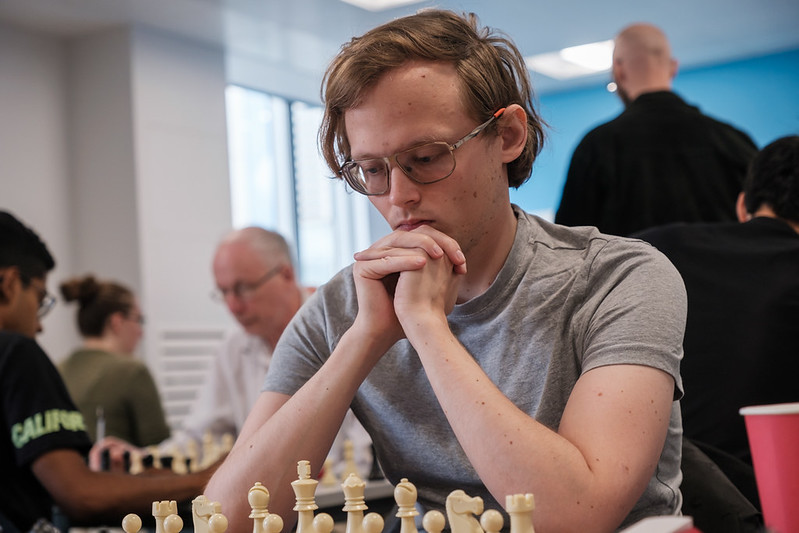
Perhaps the most attractive pairing of the round was top seed Conor Murphy, whose performance for Ireland at the 2022 Olympiad was nothing short of phenomenal, and the ever-combative Graeme Buckley. Graeme considered himself rather fortunate to have won his round 1 game and promised us solidity in round 2, but couldn’t manage it: he simply can’t help entertaining the audience. It looked very promising for him for a while in the middlegame, but around the time the queens were exchanged it started going wrong and Conor broke through decisively.
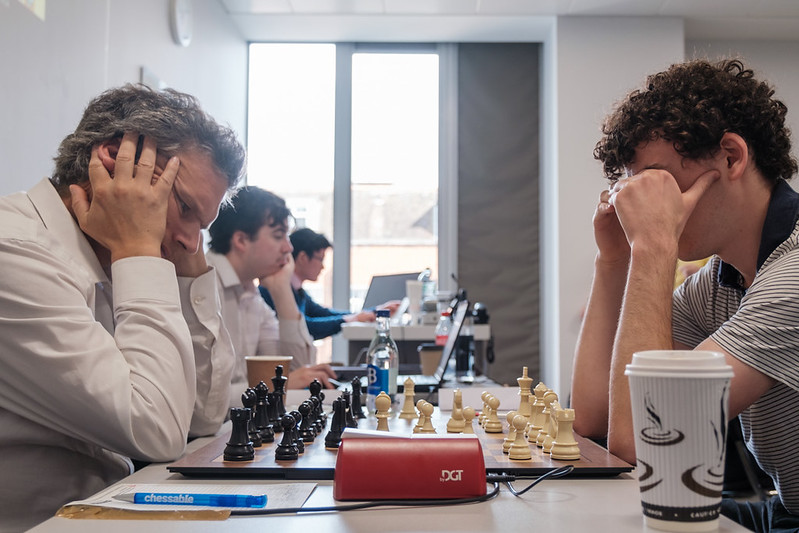
Chris Baker opened with a Ruy Lopez against David Maycock and got into difficulties when Black achieved a double attack on his c-pawn which couldn’t be adequately defended. Things looked bleak, but the wily IM managed to mix things up sufficiently for his young Mexican opponent to go wrong. As well as losing a pawn, White had previously got his bishop stuck on a vulnerable square, but he managed to solve that problem too by surrendering it and reaching an endgame where Black’s extra knight didn’t count for enough due to his shortage of pawns, and a draw was the inevitable result.
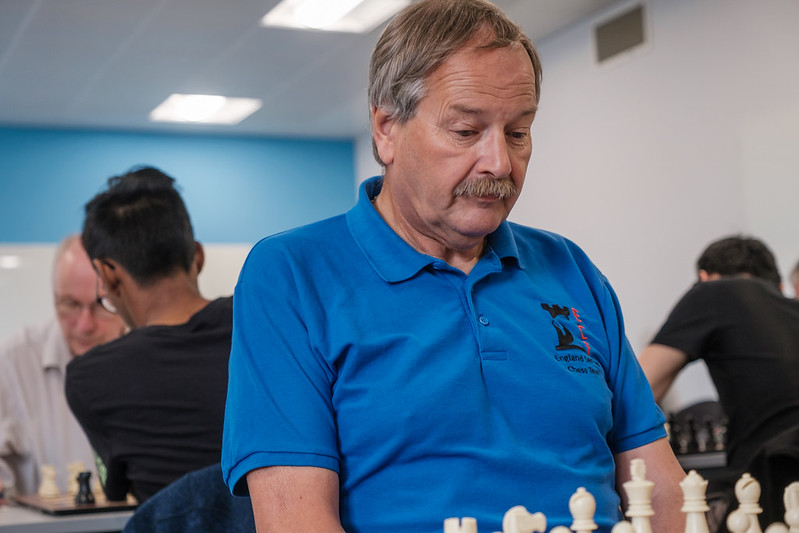
The game between Andrew Muir and Ranesh Ratnesan was long and hard-fought but never quite caught fire. That said, both players can be pleased with the fact that the analysis engines give pretty well all 61 of their moves a clean bill of health, which is something that few of us ever manage to achieve.
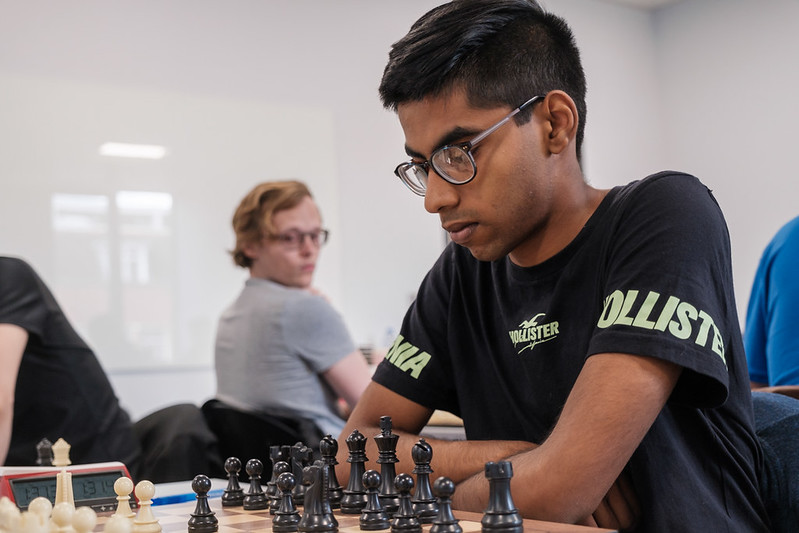
In the Fide all-play-all, Mike Healey continued his terrific start with a win against the Icelandic player Stefan Bergsson. That took him to the top of the leaderboard, though as he pointed out he started well last year before fading. The other four games were well-contested draws, demonstrating how closely matched the 10 players in this section of the tournament are.
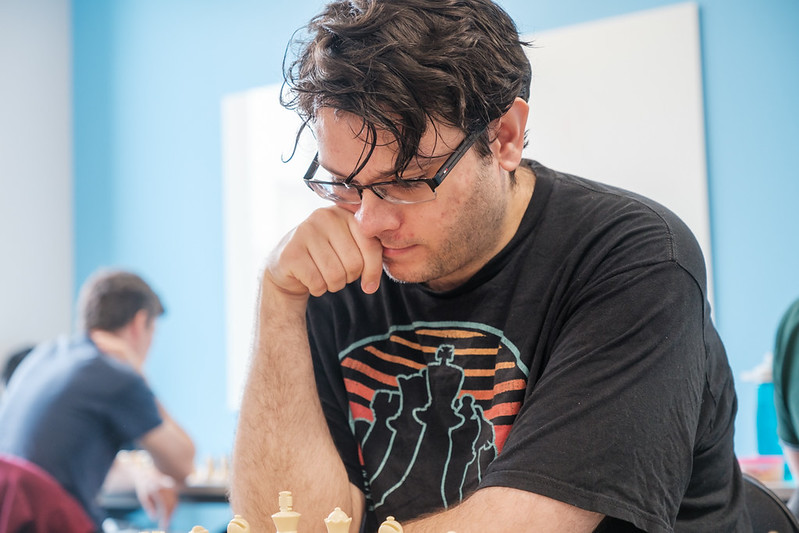
The afternoon session in the norm tournament saw another hard-fought round, with three decisive encounters and a change in the leadership. By the end of Tuesday, top seed Conor Murphy led with 2.5/3, ahead of Vladimir Li on 2/3 and Peter Large and Graeme Buckley on 2/4.
Vladimir Li and Chris Baker drew in 14 moves. The opening transposed into a Pirc Defence in which White’s light-squared bishop unusually developed at b5 and was exchanged for a knight on c6. Engines prefer White in the final position.
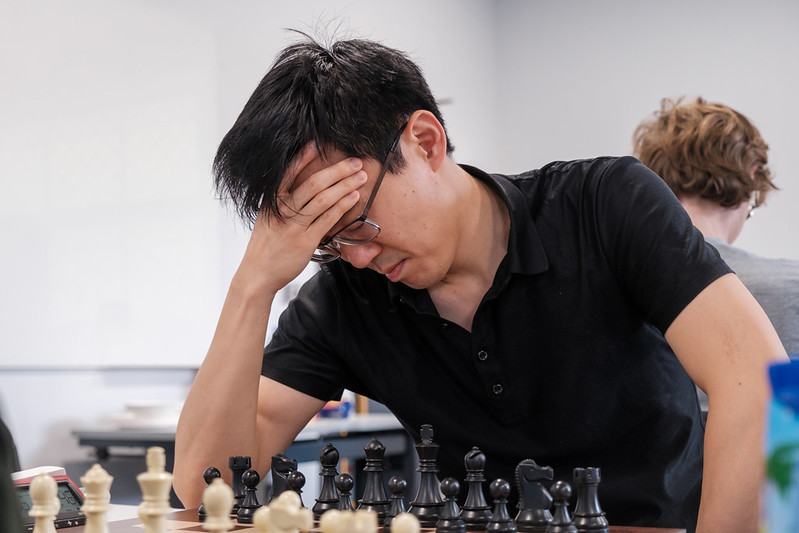
As always Graeme Buckley’s game, this time against IM Andrew Muir, provided entertainment for the spectators. The opening was a Bb5 Sicilian and resulted in two bishop-for-knight exchanges, one by each player, and a block of four doubled pawns on the c-file. But White soon established a powerful bind along the b-file, tying the enemy rooks to a solely defensive job. That wouldn’t have been the end of the story, but Buckley was soon able to open lines on the kingside, after which his bishop and queen swooped in with deadly effect.
Ranesh Ratnesan opened with a Queen’s Gambit against Peter Lalić, with the game proceeding down a more orthodox route than we are accustomed to seeing from the latter. However, just as Ranesh found a clever way to round up Black’s isolated b-pawn, Peter countered with a piece-for-pawns sacrifice. Ranesh decided the best way forward was to sac back, but that may not have been the best decision as the game fizzled out to a draw.
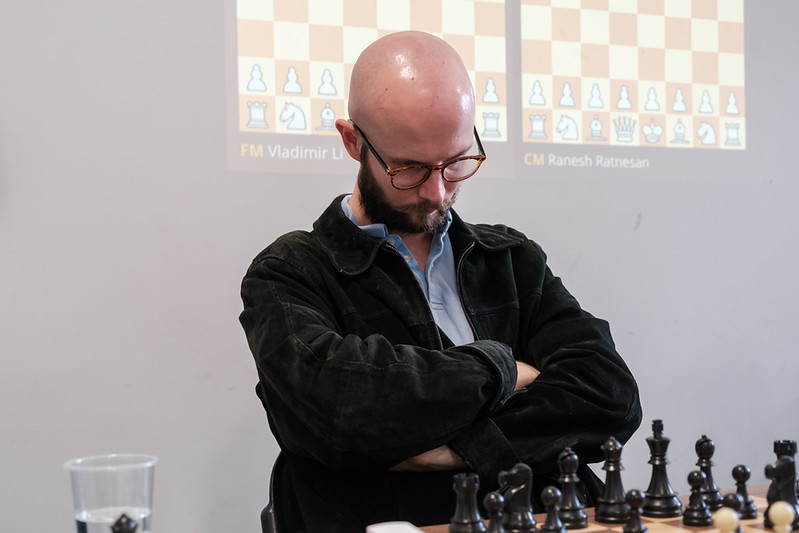
The game between David Maycock and Roland Bezuidenhout was a game of two halves (or even three – I was never much of a mathematician). The opening was a French with 3. e5. Black failed to establish viable counterplay against White’s kingside play, and was close to lost for much of the middlegame after a well-judged piece sacrifice opened up lines and gave White more than enough compensation. That’s what the engines indicated anyway, but for a human player it proved too tricky to navigate the complications. White’s position gradually deteriorated from drawn to lost.
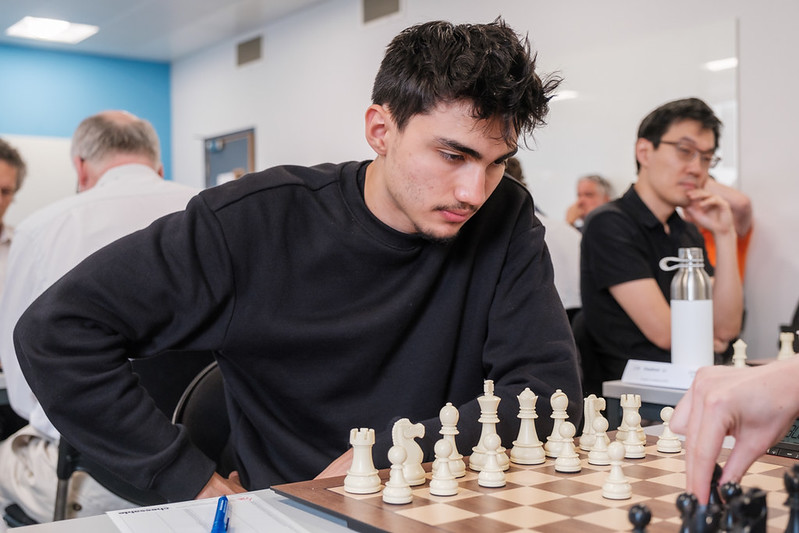
Conor Murphy overtook the erstwhile leader Peter Large in another long and complex game between the two IMs. The opening was an exchange Ruy Lopez, and very gradually Black engineered pressure along the d-file. Under considerable positional pressure White felt obliged to sacrifice a piece to start a queenside offensive, but it soon rebounded on him and Black’s mating attack crashed through.

In the all-play-all, old rivals Mike Healey and Mark Josse sued for peace fairly early, leaving Healey in the lead on 2.5/3 (and with a healthy gain in Fide points) and Josse unbeaten after three draws. Phil Makepeace likewise made peace with Rob Willmoth, and Zoe Varney and Tim Seymour also drew, putting Tim in second place on 2/3 alongside Alistair Hill.
Top seed Daniel Johnson continued his poor start to the tournament with a defeat to Hill, who had the black pieces, and Will Taylor registered his first win in the event, going the exchange up before using his pawns to prise open Stefan Bergsson’s kingside.
John Saunders
Day 3: Wednesday 26 July

By winning his fourth-round game with David Maycock, top seed Conor Murphy opened up a one-point lead in the IM norm tournament. His score after the Wednesday morning round was 3.5/4, with Vladimir Li in sole second place with 2.5, and three others on a 50% score. Meanwhile, in the Fide all-play-all, Alistair Hill and Michael Healey led with 3/4, ahead of Tim Seymour and Mark Josse on 2.5.
The game between Chris Baker and Ranesh Ratnesan opened with a cagey Réti Opening, with a side order of Larsen (b3), and lasted just 17 moves. White crossed the fourth rank twice only, and on the second occasion accompanied the move with a draw offer, which was accepted.
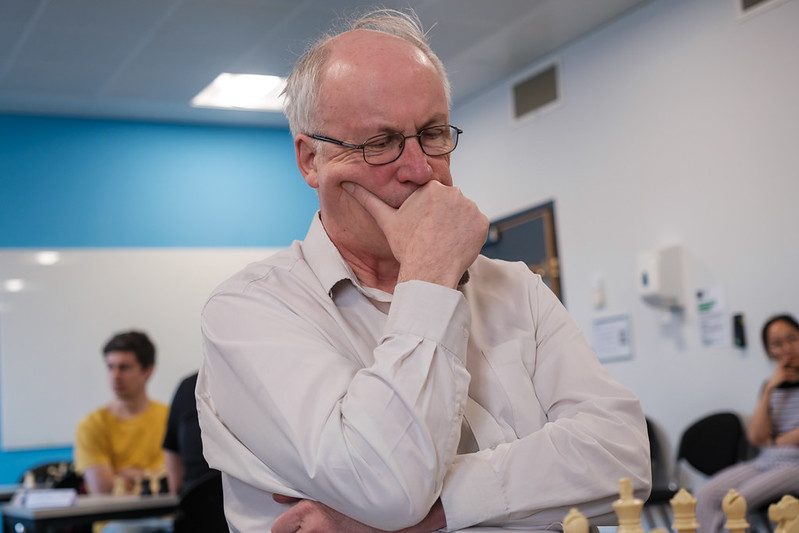
Andrew Muir v Peter Lalić lasted longer in terms of elapsed time but was shorter on moves. There were just 11 of them. This reminds me of endless debates in the 1960s and 1970s chess press about grandmasters agreeing to 11-move draws. It started me wondering what was special about the number 11. I feel I ought to know, but don’t. Answers on a postcard, please.
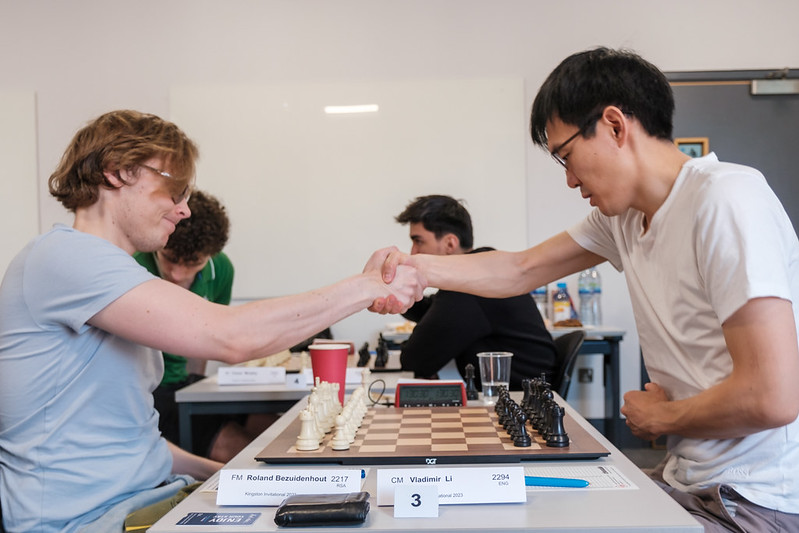
Vladimir Li and Roland Bezuidenhout also called it quits after 17 moves. Is 17 the new 11 for the 21st century? The opening was an English with a Dutch dressing (…f5), but the queens disappeared on move 7. It appears that Black was having slightly the better of things at the end but evidently Vladimir, playing Black, didn’t think it worth pursuing.
The one decisive encounter of the day went in favour of Conor Murphy, who appears to be channelling his 2022 Olympiad form at the moment. My understanding is that he already has the necessary GM norm requirements, under the recently revised Fide regulations, and it only remains for him to raise his rating to the requisite level.
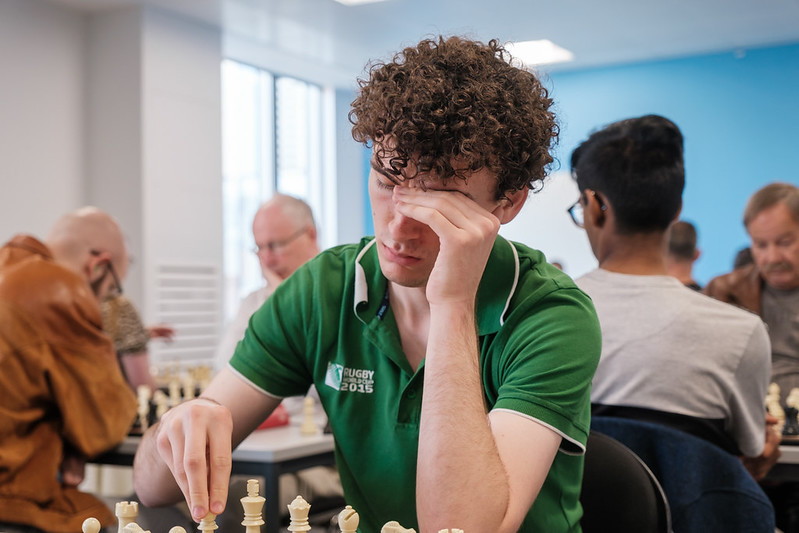
I think the first time I saw Conor play was in 2017 when he was rated a modest 2077 and lost on board 6 for Cambridge. By the following year, he had leapt up to 2312 and was board 1 for the Light Blues. His progress since has been equally rapid and was evident in the way he pursued victory against David Maycock.
The opening was a Giuoco Pianissimo (nobody launches 5. d4 any more) and developed into a fairly even game in which White had a good-ish knight against Black’s suboptimal but not entirely bad bishop, plus a rook each. It didn’t look winnable for White, but Conor continued to press Carlsen-style until David cracked, fatally, on move 72.
For those wondering why there were only four live norm-tournament games in the morning, the encounter between Graeme Buckley and Peter Large was played in advance before round one on Monday and is mentioned briefly in the report for that round. It opened with a Ruy Lopez in which Graeme, playing White, got into a little trouble after his 15th move and had to give up a pawn. However, he managed to right the ship and equalised, or at least was only a little worse by the time control. Thereafter his game went downhill and Peter was able to chalk up the point.
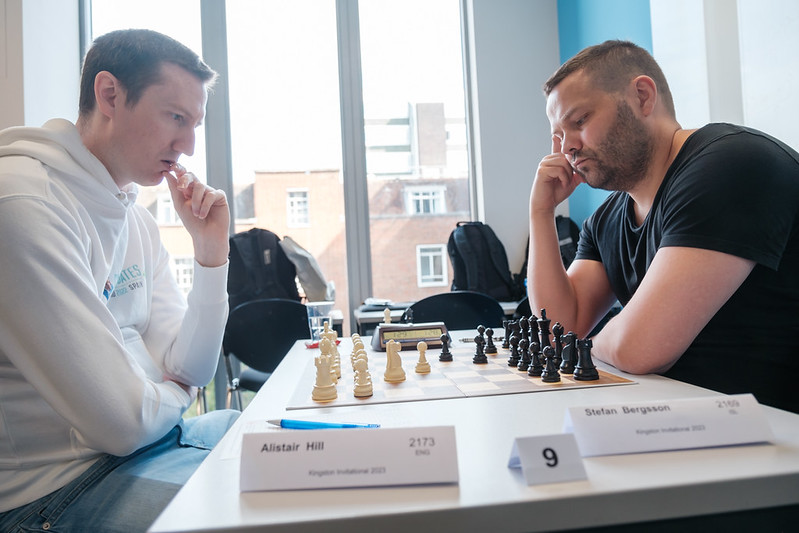
There were two decisive results in the morning round of the Fide all-play-all: Alistair Hill defeated Stefan Bergsson and Mark Josse, with Black, beat Will Taylor. After round 4 the two overseas players, Stefan Bergsson (Iceland) and Daniel Johnson (Sweden), found themselves trailing behind the home contingent, but we’re hoping their luck changes soon.
Stefan tells us that after Kingston he has two more tournaments lined up in Portugal and Germany. He is a King’s Indian Defence player, like the writer of these reports was before giving up the game. We KIDologists, reviled as we are by organic and digital entities alike (eg Korchnoi and Stockfish), know the true nature of chessboard suffering with our endless grovelling on the back rank waiting to be put out of our misery, and I’m rooting for Stefan to bounce back, either here or on his travels round continental Europe.

A lively afternoon’s play saw Conor Murphy consolidate his lead in the norm tournament with a draw against Vladimir Li. He now stands on 4/5, a point clear of Li, Graeme Buckley and Roland Bezuidenhout on 3. The two Peters, Large and Lalić, are on 2.5, Chris Baker and Andrew Muir have 2, while David Maycock and Ranesh Ratnesan have 1.5.
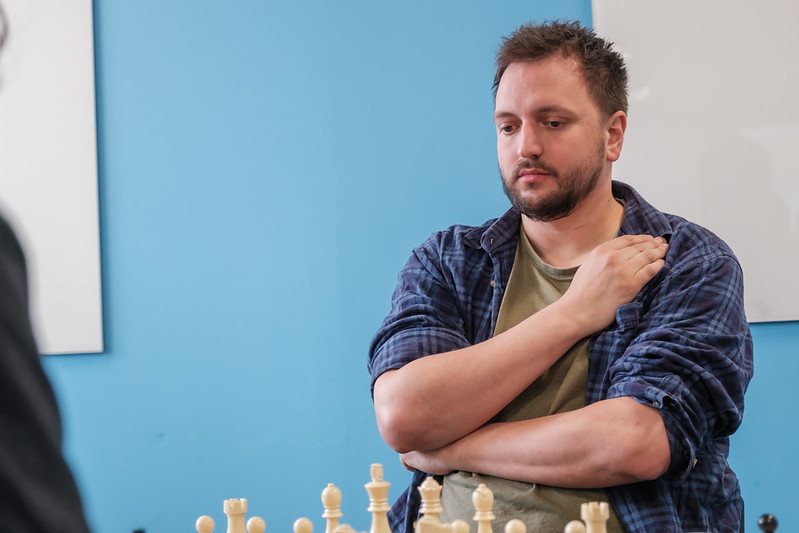
In the Fide all-play-all, erstwhile co-leader Mike Healey lost to Phil Makepeace, and now Alistair Hill shares the lead with Tim Seymour (who beat Stefan Bergsson) on 3.5/5. Healey is half a point behind jointly with Mark Josse. The other decisive result was Daniel Johnson’s win against Zoe Varney after a tough struggle in which Zoe played for a long period on the 30-second increment.

In the norm group, Peter Lalić versus Chris Baker was over in 14 moves. I looked up from my seat in the playing hall, saw the players leave, assumed they had drawn and carried on with my various computer tasks. It was only later when chatting with tournament organiser Stephen Moss that I learnt the game had ended 1-0.
As we know, Peter Lalić likes to try wacky openings, but it seems Chris Baker was determined to out-wacky him. The opening was a Nimzowitsch Defence, with the c6 knight being chased across the board by pawns in a similar way to the f6 knight in Alekhine’s Defence. But this slice of opening creativity proved too hazardous as Harry the h-pawn joined in with the bullying of the hapless horse, which retreated to f8, incongruously beside his cavalry colleague, still unmoved on g8.
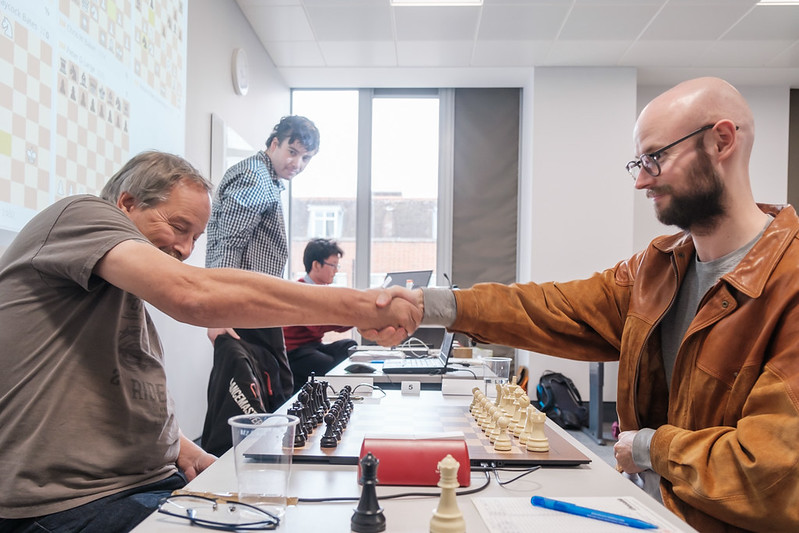
Peter, sensing blood, attacked the queen with 8. Bg5, which could have been parried with 8…f6, but Chris chose 8…Qd7 and after that, it was curtains as a feeding frenzy of minor pieces set upon the queen, smashed open the d-file and forced the win. Peter will reflect on a remarkably economical day at the office: 1.5 points gained (against two IMs!) from just 25 moves played.
The afternoon round featured a game between the leader and his nearest pursuer. Conor Murphy, on 3.5, was content to halve out with Black against Vladimir Li, on 2.5, thus maintaining the one-point cushion. The opening was an English, Neo-Catalan, with Black achieving smooth development at the cost of the two bishops. The peace treaty was signed at move 22.
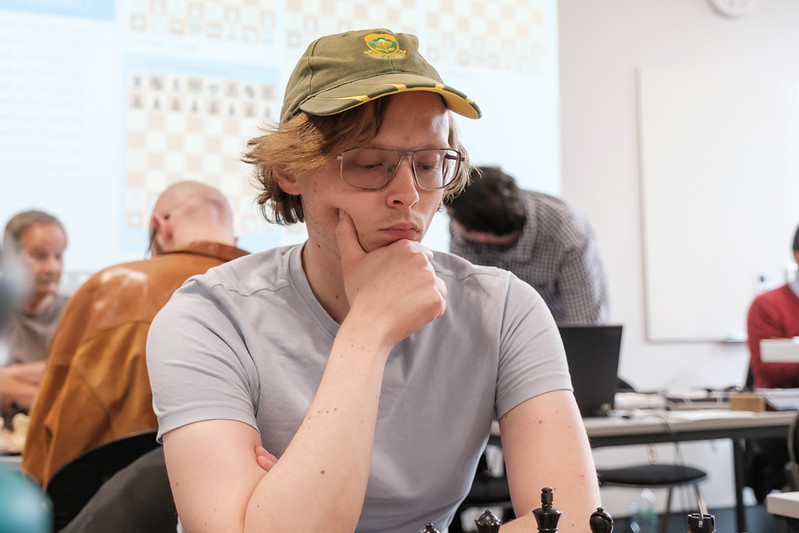
The third game to finish was Ranesh Ratnesan vs Roland Bezuidenhout, with the South African player winning in 31 moves. Black emerged from the opening, a Benko Gambit, with approximate equality, but White then failed to hit upon a convincing plan and Black took the initiative. Despite White having a dark-squared bishop for a knight. Black rather dominated that colour complex and soon annexed the white d-pawn. White resigned when it became clear that he would lose a second pawn or worse.
The remaining two games of the round were long drawn-out affairs, but only one was drawn. The game between Peter Large and Andrew Muir began with an offbeat Sicilian Defence, but it didn’t look very convincing for White as Andrew rounded up Peter’s d-pawn. Things looked good for Black, but Andrew followed up with some ill-judged tactics and the advantage swung back to White. Though down a piece, Black had two pawns’ compensation and eventually material equality was restored and a draw inevitable.
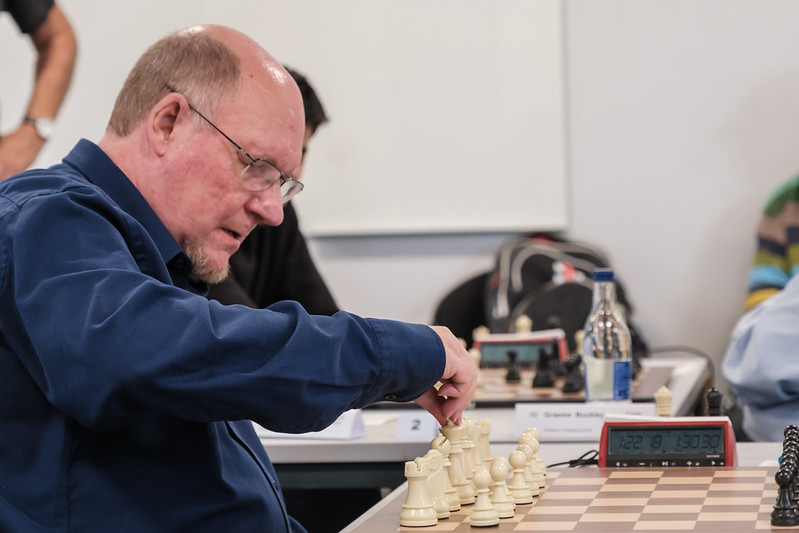
As self-appointed Hon Sec of the Graeme Buckley fan club, you know I’m going to tell you how amazingly entertaining his game against David Maycock was. But this is nothing but the pure, unvarnished truth. I tell you, Graeme never plays a dull game. David opened 1. e4 and the game went into a Sicilian line with …e6 and …Bb4. (If this line has a name, it’s not known to me.)
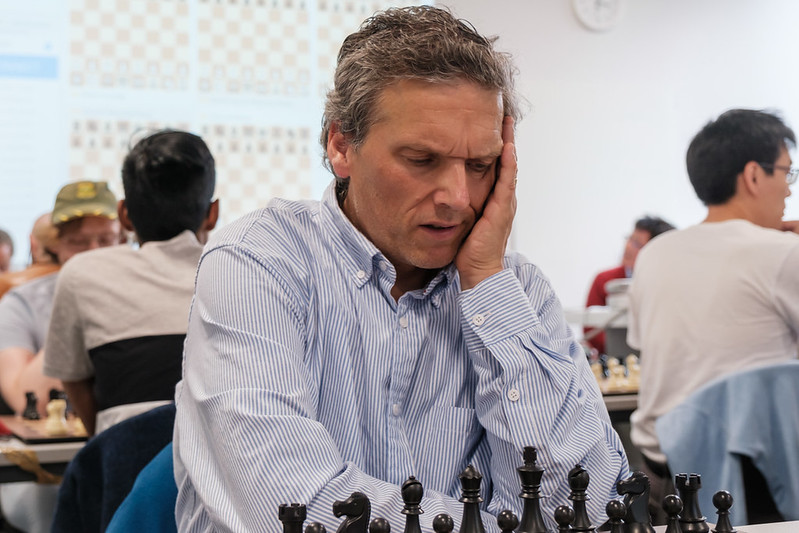
David Maycock was bold enough to chase a bishop back by moving his g-pawn forward two squares in front of his castled king. But it proved a little too hazardous. Soon the Buckley queen and rook were menacing the Maycock king, and the subsequent defence proved too problematic. Black won the exchange and, despite some tough defence from White and a few inaccuracies from Black, Graeme got the job done in 79 moves. A very tough day at the office for David Maycock: 163 moves for zero points. Compare and contrast Kingston Chess Club colleague Peter Lalić’s day (see above). Chess is a very unfair game.
John Saunders
Day 4: Thursday 27 July
The overall impression left by this remarkable round of hard-fought chess is of White bearing down on Black and grinding him into dust. Five-nil was the final score in favour of those who had the advantage of the first move in the norm tournament. Black was definitely not OK. After the morning round, the scores were Conor Murphy 5/6, a point clear of Graeme Buckley, Peter Large and Roland Bezuidenhout on 4; Vladimir Li 3.5; Andrew Muir 3; Peter Lalić 2.5; Chris Baker 2; David Maycock and Ranesh Ratnesan on 1.5.
Meanwhile, Tim Seymour became the sole leader of the Fide all-play-all following his defeat of Mark Josse. Tim is on 4.5/6 with Alistair Hill on 4, a point clear of five players on 3/6, including Zoe Varney, who was the only other player to achieve a decisive result in this round by beating Michael Healey. The two decisive games in the section were both won by White, naturally.

Andrew Muir’s game against Chris Baker started with a main line of the Nimzo-Indian. On move 14 Chris allowed a combination to win his a-pawn but in the resultant complexities there was a fleeting chance for Black to equalise. However, he missed it and instead found himself the exchange down for nothing as most of the pieces came off the board. Chris played on for a while, but it proved a routine task for Andrew to win the game in 36 moves.
Roland Bezuidenhout opened with 1. c4 against Peter Lalić, who replied with 1…d5 and then 2…c6 after his d-pawn was captured. The gambit was accepted and normal development resumed, with Black having only nebulous compensation for his pawn. Eventually, it came down to a double rook endgame, with the black rooks having some play against the slightly vulnerable white king. However, White still had his extra pawn, which was now passed and well-advanced. Peter huffed and puffed and might well have blown down the house of a lesser player, but Roland was up to the task of finishing the game. After a sticky start, Roland has gone on a run of three wins and one draw and is in the group a point adrift of the leader.
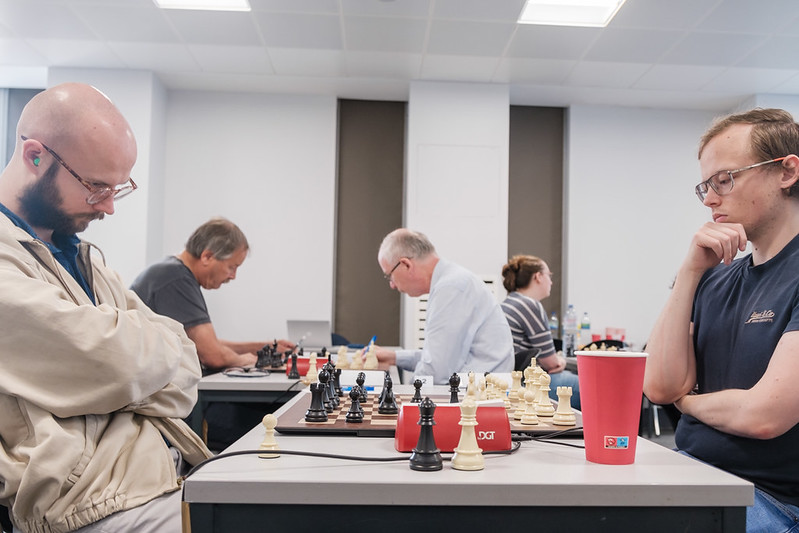
Top seed Conor Murphy was White against one of the two back-markers, Ranesh Ratnesan. A Najdorf Sicilian ensued in a line which I understand is called the Adams Attack, featuring an early h3 and g4. Ranesh’s handling of the opening looked sensible, but there must be doubts about his selection of 16…exf4 over 16…a4, pursuing his counter against the queenside-castled white king. Soon the focus was solely on Black’s kingside predicament. That said, Ranesh mounted a determined defence, managed to exchange most of the pieces and looked close to equality before the constant pressure finally told. He swung the wrong way with his knight on move 37 (…Nb6 might have been defensible) and soon lost.
Graeme Buckley chose a Trompowsky against Vladimir Li in a clash between Murphy’s nearest pursuers. Black conceded a considerable initiative to his opponent by playing 11…cxd4 and found himself in a cramped situation, with two enemy knights menacing his position. It looked grim and soon degenerated to dead lost as the white pieces exploited various weaknesses. Another excellent win for Graeme Buckley keeps him in the hunt for first place if Conor Murphy falters.
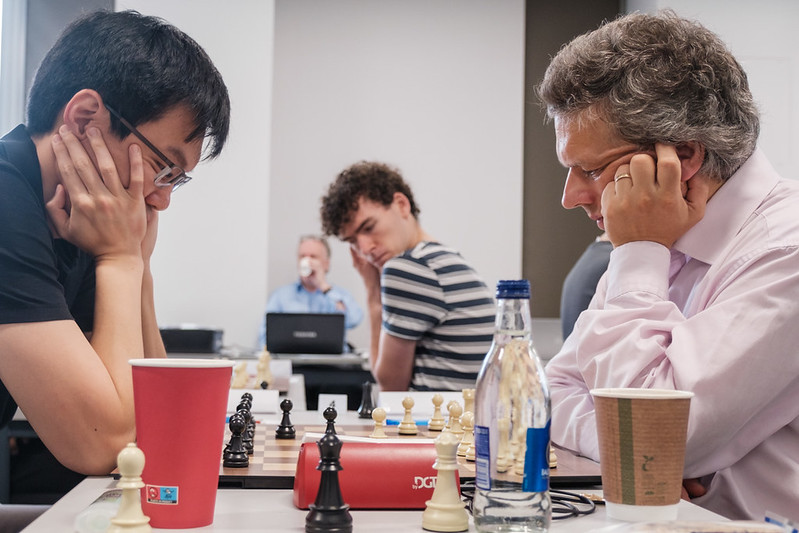
Peter Large, with White, opted for an exchange Ruy Lopez against David Maycock. Most of the material disappeared from the board as the game developed. David, perhaps affected by his run of three straight losses, tried too hard to win. He turned down a draw at some point, but the crunch came when he stranded his knight on the rim on move 26 when it could have taken a more active post, thus encouraging Peter to pursue the win. A further error by Black, allowing the white king to reach g5, sealed his fate.
The first game to finish in either tournament, around 90 minutes after the round started, was Zoe Varney’s win against Michael Healey in the all-play-all. For the second round running, Mike found himself facing the Scotch Opening and was well and truly scotched. (Sorry, that was one pun that begged to be made.) He offered a draw with his 16th move, thinking he was still in the game, but Zoe’s crushing reply disabused him of this erroneous notion and he resigned without making a further move.
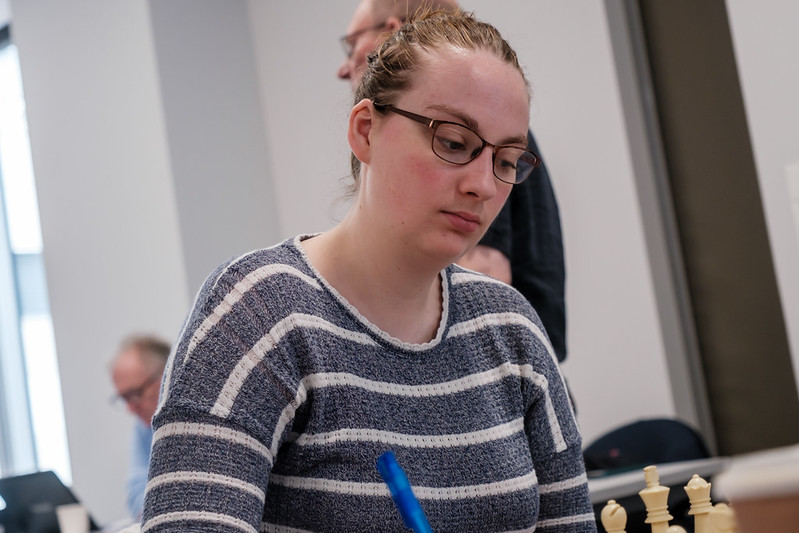
Rob Willmoth, who drew in this round with Alistair Hill, is now the only player in the all-play-all who has not yet won a game but can content himself with being unbeaten, as well as being the first player to be awarded a prize. This was for consistently wearing the best shirts throughout the event, on my recommendation to the tournament organiser. Rob was gracious enough to compliment me on my own shirt and promised me that another attractive item of gentlemen’s apparel is waiting in his wardrobe to be worn for tomorrow’s final games. I can hardly wait.
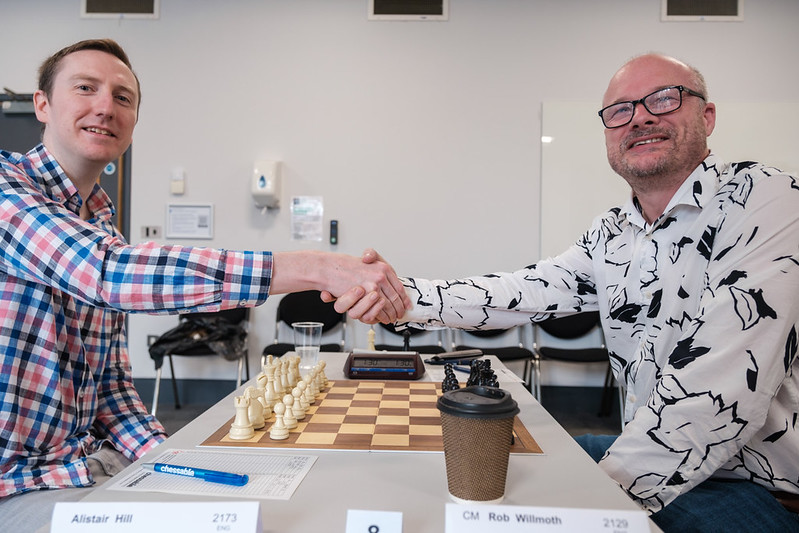
Tim Seymour assumed the lead of the all-play-all with a win against Mark Josse. The opening was a Réti of an unusual variety in which Black started to go downhill when he opened the e-file at the expense of completing his development. The e-file proved more useful to White, who used it to infiltrate the black position and set up an unshakable pin along the eighth rank.
The afternoon round of the norm tournament was not quite as ferocious as its predecessor, but there were still three decisive games and plenty of entertaining chess to enjoy. Conor Murphy won yet again, defeating Peter Lalić, to reach 6 points out of 7. Graeme Buckley also won, to keep the gap to one point, and is now in sole second place with 5. Other scores are Roland Bezuidenhout 4.5, Peter Large 4, Vladimir Li 3.5, Andrew Muir 3, David Maycock, Peter Lalić and Chris Baker 2.5, and Ranesh Ratnesan 1.5.
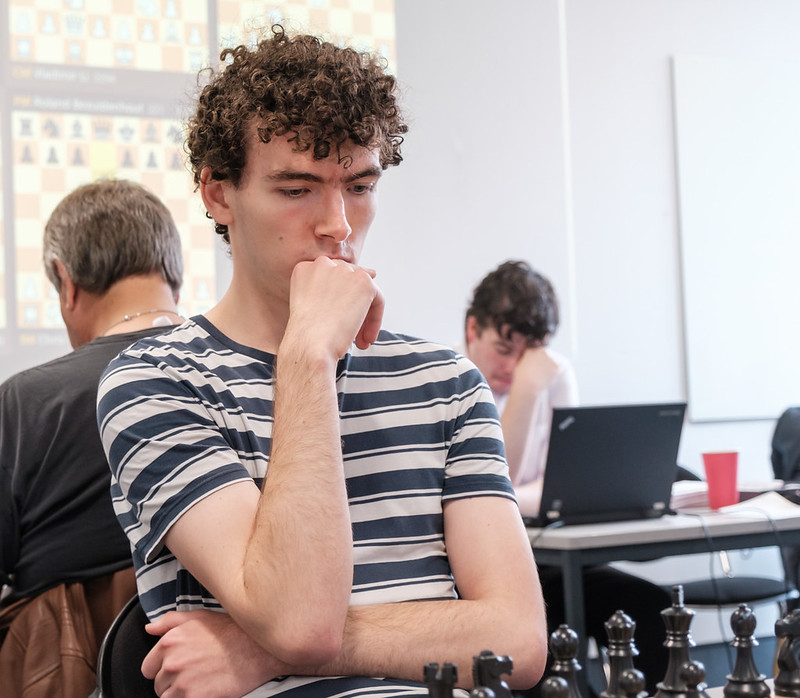
Tim Seymour still leads the Fide all-play-all with 5/7, followed by Alistair Hill 4.5, Mike Healey 4, Mark Josse, Rob Willmoth and Phil Makepeace 3.5, Daniel Johnson and Zoe Varney 3, and Stefan Bergsson and Will Taylor on 2.5.
Vladimir Li versus Peter Large lasted just under an hour before being agreed drawn. The opening was an English Neo-Catalan and proceeded down an orthodox route until move 12. White retained a nominal edge according to Stockfish 16, perhaps due to Black’s isolated c-pawn, but to the human eye it looked level enough. A draw was agreed on move 17.
Chris Baker drew in 30 moves against Roland Bezuidenhout in a Hanham variation of Philidor’s Defence. This is a passive but solid line which leaves White with the initiative, but Roland negotiated the problems well enough. Chris took a risk with 19 Bxg7, allowing Black to break out with some kingside play that at least equalised. It’s possible that Black might have had more with best play, but it soon boiled down to an opposite-coloured bishop ending.
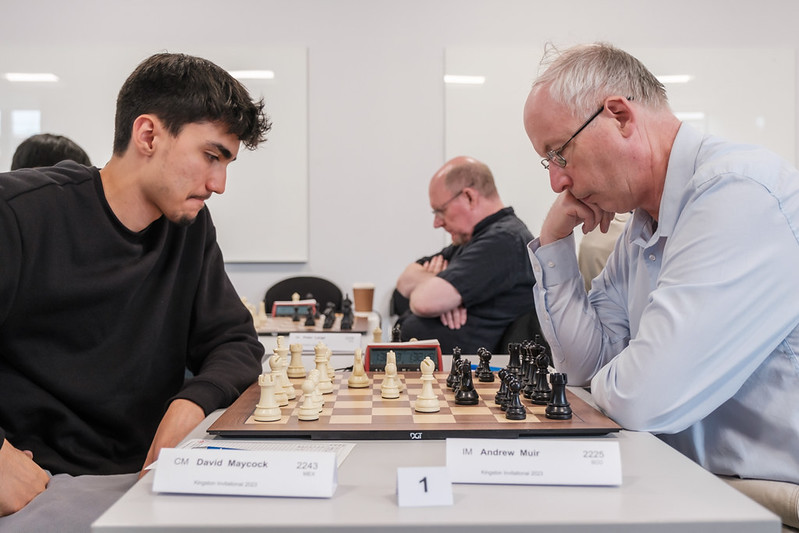
David Maycock faced Andrew Muir and the dire prospect of a fifth consecutive loss if he slipped up. But there was an air of determination about his demeanour as if he was cross with himself and not prepared to let disaster strike again. Andrew played the Sicilian Defence and David countered with the Richter-Rauzer attack. The book was followed for a dozen or so moves, with 14…Qa7 looking like a tacit queen exchange and a draw offer from Andrew. But David kept the queens on the board and was rewarded a couple of moves later when Andrew unwisely castled queenside. David immediately launched his a-pawn down the board and soon opened up lines against the black king. Andrew found himself engulfed in an overwhelming attack and resigned.
Ranesh Ratnesan’s game against Graeme Buckley began with a Benko Gambit. It looked bookish until move 16, where White might have tried Bxe7 instead of retreating his bishop. Black soon regained his gambit pawn and was able to go into pawn surplus when Ranesh allowed the dark-squared bishops to be swapped. It looked dire for White. Though the game went on for some time into the evening, the resultant endgame of rook plus two unconnected pawns versus rook was ultimately conclusive.

Peter Lalić served up a Danish Gambit to tournament leader Conor Murphy, who responded with 3…Qe7, which is a different way of accepting the gambit pawn. Peter tempted Conor with another delicious pawn which was duly consumed. In return, Peter secured some dangerous tactical chances against Black’s king. This might have given a bad case of indigestion to any ordinary mortal in charge of the black pieces against a player as imaginative as Peter, but we must remember that Conor is on course to become a GM in the near future and not to be trifled with.
Next, Peter tossed him a knight, like a fish to a performing seal. It was expertly swallowed. Though Black lost his queen in the resultant melee, in return he received more than adequate compensation: rook, bishop and knight. Once again you felt that Peter’s agile queen might have performed a merry dance around a lesser player as Conor’s king was left a little exposed, but the Irish IM had judged it to a nicety. It took a little time to get Black’s small commando force marshalled against the queen, but once achieved the result wasn’t in doubt.
In the Fide all-play-all, Tim Seymour maintained his lead with a steady draw with Black against Rob Willmoth. It’s possible that Rob could have kept an edge with the queens still on the board, but after they were exchanged Tim’s position proved resilient.
Alistair Hill defended a main-line Caro-Kann against Phil Makepeace. It was a low-key game in which both sides vied for a small positional edge, and it wasn’t a surprise when they called it quits at move 23.
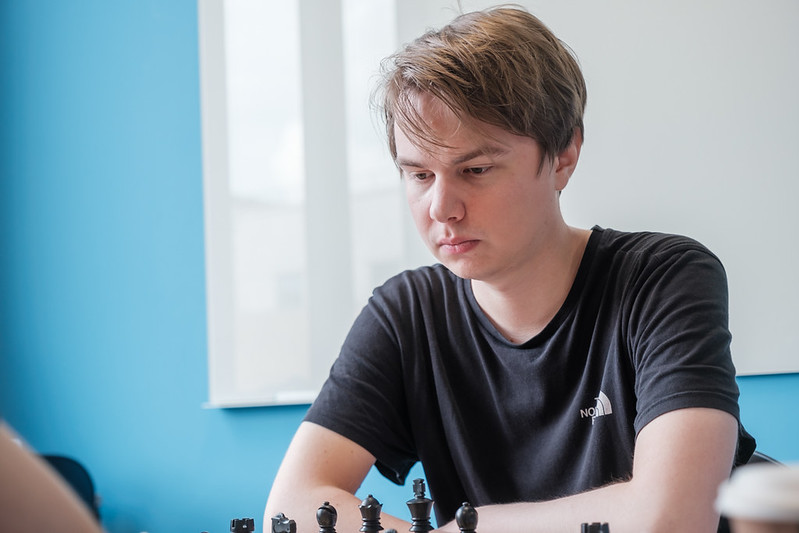
Mark Josse and Daniel Johnson drew in 20 moves. The opening was a Queen’s Gambit Declined Exchange variation, and the game stayed close to book lines for much of its course.
Mike Healey, back in charge of the white pieces against Will Taylor after what we might term Double Scotch intoxication, seemed to play the opening (a homebrew Closed Sicilian) in a carefree way. However, Will was unable to exploit this, and White gradually built his position up to equality. The game meandered on inconclusively until move 42 when Will allowed a horrid tactic which cost him a piece and the game shortly after.
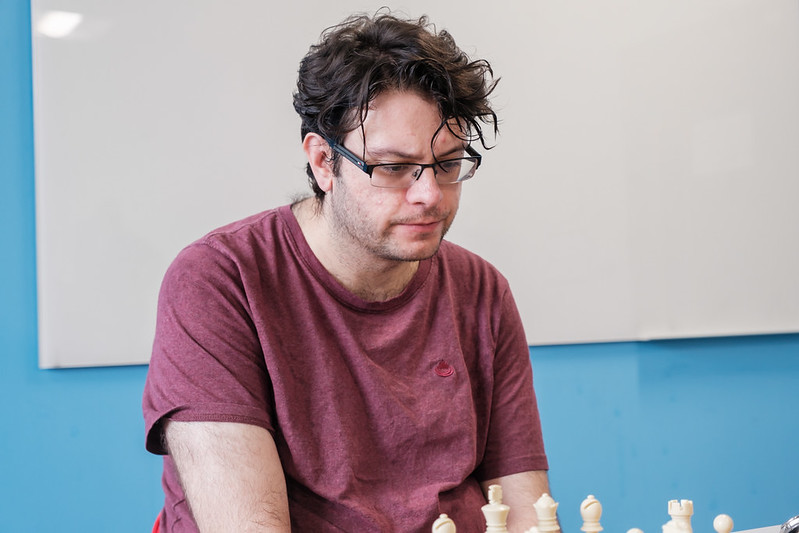
The game between Stefan Bergsson and Zoe Varney began with a Bishop’s Opening, with Zoe opting to lop off the c4 bishop with a quick Na5xb3. But the two bishops proved not to be a particular asset. Black’s development wasn’t optimal and White managed to secure some dangerous attacking chances in a position where it was hard for Black to get her rook and bishop into play. In a position which was already perilous, Black went wrong and allowed a deadly combination starting with Ng6+. There was one misstep by White which might have allowed an improbable escape for Black but would have been extremely hard for a human brain to find. Stefan can be pleased with his second win after a bleak run of results, while Zoe can reflect on a day of two halves.
John Saunders
Day 5: Friday 28 July
In the penultimate round on Friday morning, Conor Murphy made sure of sole first place in the norm section with a round to spare by beating Chris Baker. Graeme Buckley’s attempt to keep pace with him nearly succeeded, but in the end, he was held to a draw by Peter Lalić. Scores after round 8: Conor Murphy 7/8; Graeme Buckley 5.5; Peter Large and Roland Bezuidenhuit 5; Vladimir Li 4.5; Andrew Muir 3.5; Peter Lalić 3; David Maycock and Chris Baker 2.5; Ranesh Ratnesan 1.5. Scores of the Fide all-play-all: Tim Seymour 6/8; Alistair Hill 5.5; Mark Josse, MikeHealey and Rob Willmoth 4; Zoe Varney, Daniel Johnson and Phil Makepeace 3.5; Will Taylor and Stefan Bergsson 3.

Andrew Muir versus Roland Bezuidenhout started life as a Benko Gambit Accepted. White returned the pawn and steered for a largely symmetrical pawn structure which didn’t demand intense tactical calculations. The draw was agreed upon after 29 moves and just over two and a half hours’ play.
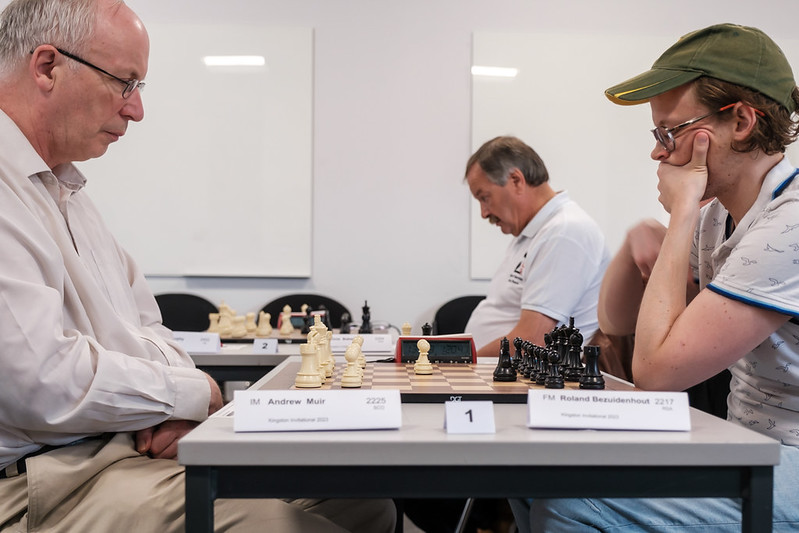
Conor Murphy adopted a Giuoco Pianissimo set-up against Chris Baker as he had done previously in round 4. Chris chose to defend a quieter …d6 line. White nursed a slight edge for some time until he saw an opportunity to exchange queens and a pair of minor pieces in order to open the e-file. This plan didn’t seem at all obvious to me or indeed Stockfish, but it maintained White’s edge. However, the game came to a sudden end when Black played 30…Kf6 and White replied 31. Ng5. It wasn’t an obviously fatal blow in that mate or a huge loss of material were imminent, but it became clear that Black would have no viable counterplay against White’s various threats, so Black simply resigned.
Graeme Buckley, playing against his stepson Peter Lalić, opened with a Réti, but Peter immediately derailed orthodoxy with a pawn gambit, after which White was content to see multiple exchanges to bypass the middlegame altogether and proceed straight to an endgame in which he was a pawn up, albeit with doubled pawns and other slight positional minuses. It always looked as if White would win eventually, but Black managed to construct a series of blockades which stymied various tries by White to make progress. Eventually, at move 75, Graeme gave up the attempt and acquiesced to a draw. Stockfish found a way for White to continue to press his case, but it wasn’t conclusive.

Peter Large opened with a Nimzowitsch-Larsen Attack against tournament back-marker Ranesh Ratnesan. Ranesh allowed Peter to secure the two bishops at an early juncture and his remaining cleric was chased into a hole on the kingside, reminding the writer of the priest holes of 16th- and 17th-century English history.
I can empathise with Ranesh’s situation in the tournament as I have been there myself on more than one occasion. It is probably very wrong of me to compare the metaphorical persecution suffered by chess players in this predicament with that of Catholic priests facing the all too real danger of death from religious zealots, but I confess the ignoble thought did cross my mind. When the lonely priest emerged from his hiding place, he was put to the sword immediately as White unfurled a tactic to secure two bishops for a rook. What was worse for Black was that the two prelates were both lodged securely and menacingly in the centre. In truth these were archbishops, Canterbury and York, controlling the whole board and making Black’s major pieces seem very minor indeed. Theocracy soon triumphed.
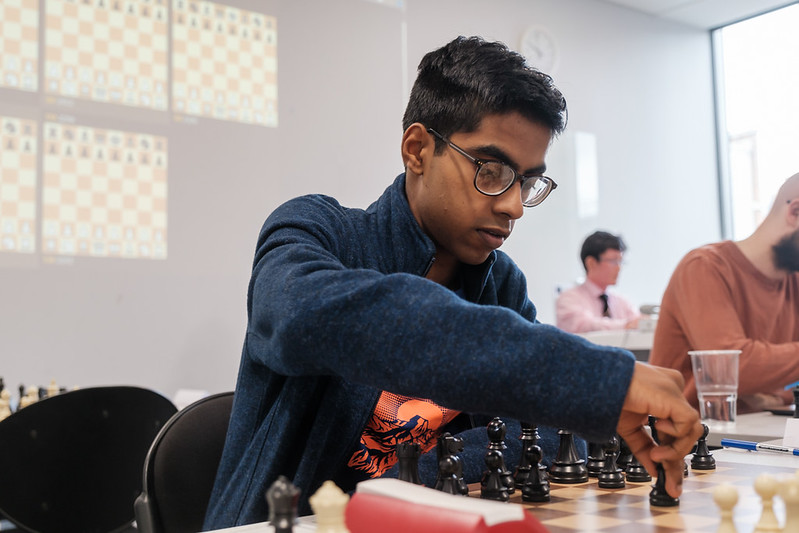
The game between Kingston Chess Club colleagues David Maycock and Vladimir Li began with an Open Ruy Lopez. David launched an impulsive 10. c4 where 10. Rd1 normally gets played, giving up a pawn. As with some of the other unorthodox pawn gambits we’ve seen tried in this tournament, it carried sufficient venom to poleaxe a patzer, but there are no players fitting that description in the tournament line-up. Vladimir is immune to such stratagems. He effected a few exchanges, still with his pawn advantage, and then piled in on David’s denuded kingside with a mating attack.
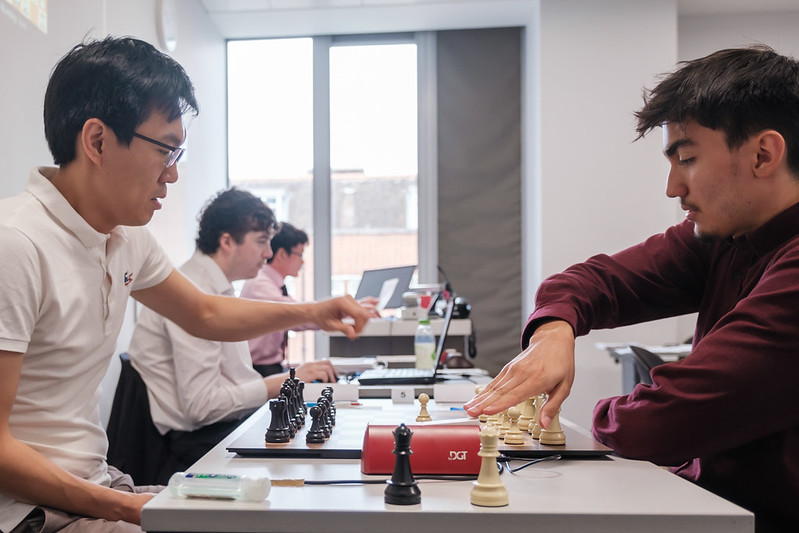
In the Fide all-play-all, Tim Seymour maintained his lead with a win against Phil Makepeace, while his closest rival Alistair Hill defeated Michael Healey. First place was now between these two, with the rest of the field 1.5 points adrift.
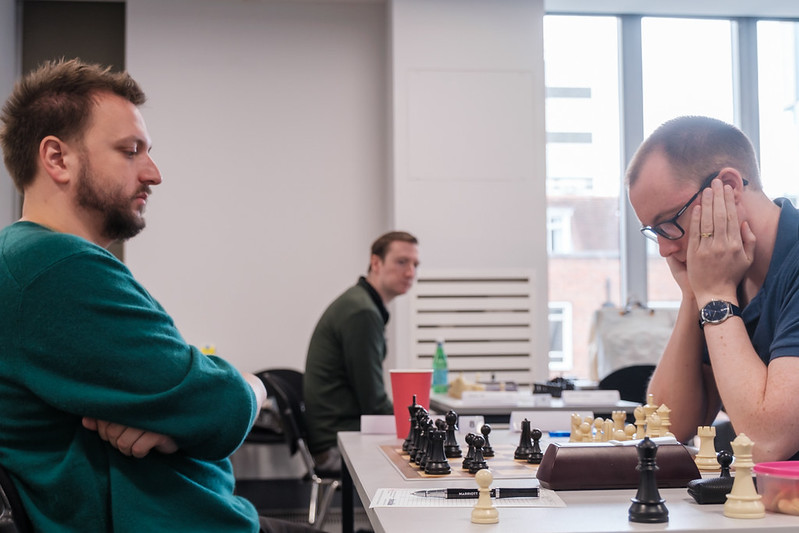
So to the afternoon session, the final one of the five-day festival, with the temperature hotting up, the playing room becoming a little stuffy and water consumption rising exponentially. One of the players even called for ice cubes at one point, which were obligingly provided by the local pub.
With Conor Murphy having secured first prize (£250) in the norm tournament with a round to spare, it still left the matter of subsidiary prizes. The one change to the order came when Peter Lalić succumbed to Peter Large in the last game of the tournament to finish.
The game between Vladimir Li and Andrew Muir was brief – just 13 moves. The opening was a c3 Sicilian, which used to be my trusty, theory-dodging weapon of choice against the Sicilian, and is quite a good choice for players focused on their journey home at the end of a tournament. The queens came off on move 7 and a few other pieces were hoovered up before the inevitable draw by eye contact – the preferred method of ending a game between pro players unsure of their opponent’s first language, though superfluous here as Vlad and Andrew both speak English. Vladimir finished on 5/9 for a minute gain in rating while Andrew scored 4 for a similarly tiny drop in rating.
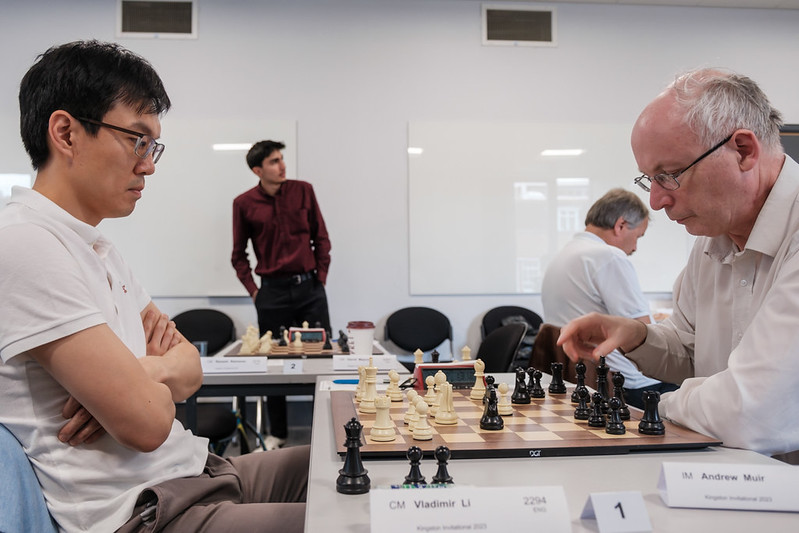
Ranesh Ratnesan played the white side of a Sämisch Nimzo-Indian against David Maycock. Ranesh’s performance reminds me more and more of my own debut in an IM norm all-play-all, in Cardiff 1997, where I started with a dismal 0.5/6 (the half was against a very young Luke McShane), then battled my way to two draws and reached 2.5/9 with a last-round win against IM Richard Tozer. Not much of a score, but in the end I couldn’t have been happier.
A last-round win is a cure-all for caïssic calamity. And, would you believe it, Ranesh soon found himself in a highly advantageous position against David, who once again had gone all-out for the counterattack and compromised his position. Soon Ranesh had an overwhelming position according to the engines. He found the gorgeous 35. a4!! in the position below, which teed up a winning finish.
Or at least it seemed to do so, but having played A, Ranesh failed to find B and C, namely Qh6 followed by Rh2, which would have allowed a long and vertiginous sequence of checks from Black’s queen and even allowed a check from the enemy rook before the checks run out and White gives mate. In truth, it was a typical engine line which might have been beyond the calculation skills even of a super-GM. Without precise calculation, it would have been too big a risk, and Ranesh decided against it and soon offered a draw.
The other winless player in the IM event was Chris Baker, playing White in the final round against the redoubtable Graeme Buckley, who was probably still coming to terms with his previous game having ended in a draw (his first of the tournament). The opening was a Queen’s Gambit Declined Tarrasch, and White carefully nursed his opening edge into the middlegame, not allowing Graeme the sort of action that he thrives on. White eventually won a pawn but in a position with reduced material in which it didn’t look unduly worrying for Black. Further exchanges left a rook and pawn ending which was a tablebase draw.
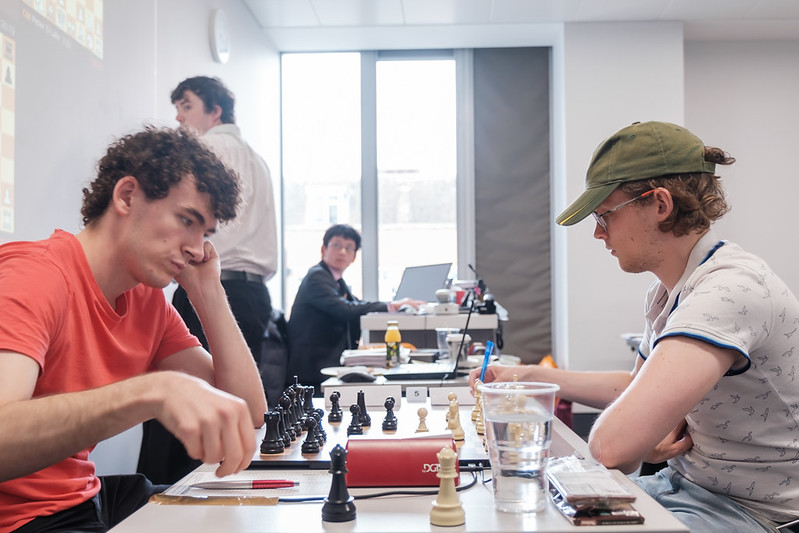
The opening of Bezuidenhout-Murphy was a Closed English with an early …f5. When I first looked at, around move 16, Stockfish was indicating a +0.80 advantage for … Murphy’s opponent! Having become used to Conor having a series of excellent positions over four days, an advantage to his opponent looked surreal. However, that advantage was not realised, because the move flagged by the engine, 16. h4, wasn’t played. Instead, Roland played 16. Nxd4, and the evaluation number decreased to something closer to equal. It came down to a level minor-piece ending, and a draw was agreed on move 30.
The battle of the two Peters, Lalić and Large, started life as a Caro-Kann. With the queens coming off at move 9, we might have been forgiven for expecting a quick draw was imminent, but this was destined to be the longest game of the round. Indeed it had the potential to be one of those arbiter’s heart-breakers which goes on long after the officials had hoped to pack away all the kit and go to the pub.
But, in the end, not quite. White had rather the better of things for the first 20 moves or so but after that it was simply equal and, if truth be told, a bit dull. Then it became interesting again as Peter the Elder managed to lose a couple of pawns which Peter the Younger happily consumed. This could and should have been the end of the story, but White got his pieces in a tangle and the black rooks and bishop suddenly bore down on the white king in murderous fashion. But Black’s follow-up was inaccurate and suddenly it was equal again. But even that wasn’t the end of a game of at least three halves as the younger man blundered on move 60 and this time there was no way out.
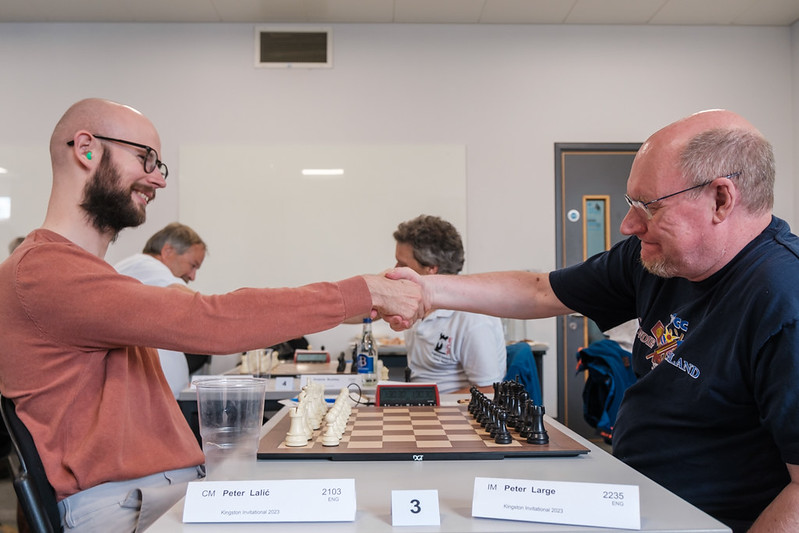
In the Fide all-play-all, two of the games, Willmoth-Bergsson and Makepeace-Johnson, ended fairly quickly in draws. That left the battle for first place over two boards, Healey-Seymour and Hill-Taylor, plus the game between Mark Josse and Zoe Varney. These were all lengthy struggles.
Tim Seymour eventually agreed to a draw with Mike Healey, leaving the possibility open of Alistair Hill catching him if he could overcome Will Taylor. This Alistair managed to do after a long struggle. That meant they shared the prize, but Tim Seymour was awarded the trophy on rating performance. The final game of the entire congress finished when Zoe Varley and Mark Josse agreeing a draw and we could proceed to the prizegiving.
John Saunders
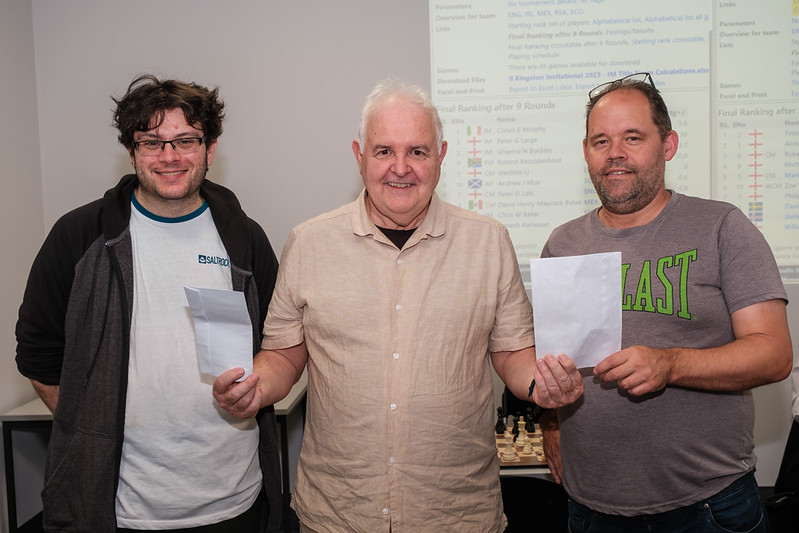
(centre). The other third-prize winner, Rob Willmoth, is absent. Photograph John Saunders
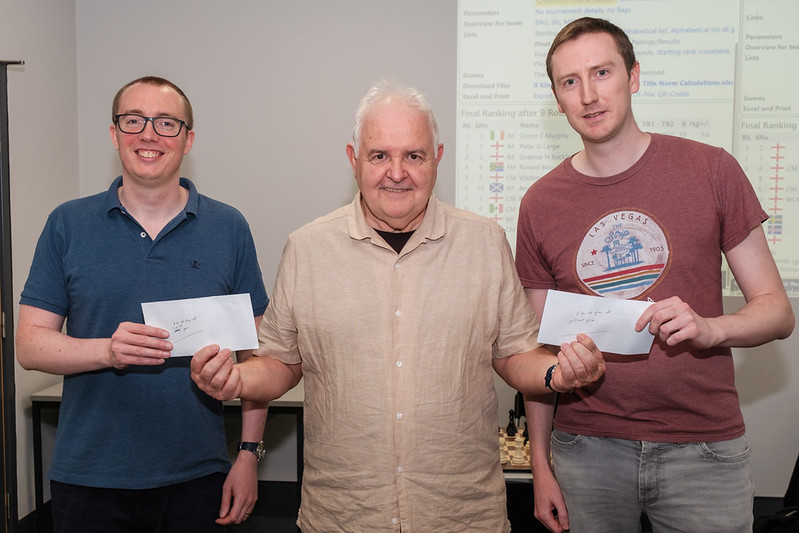
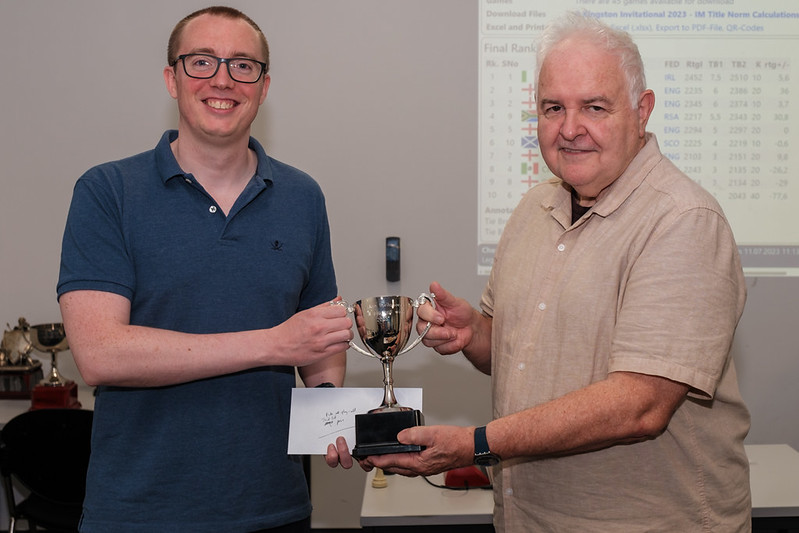
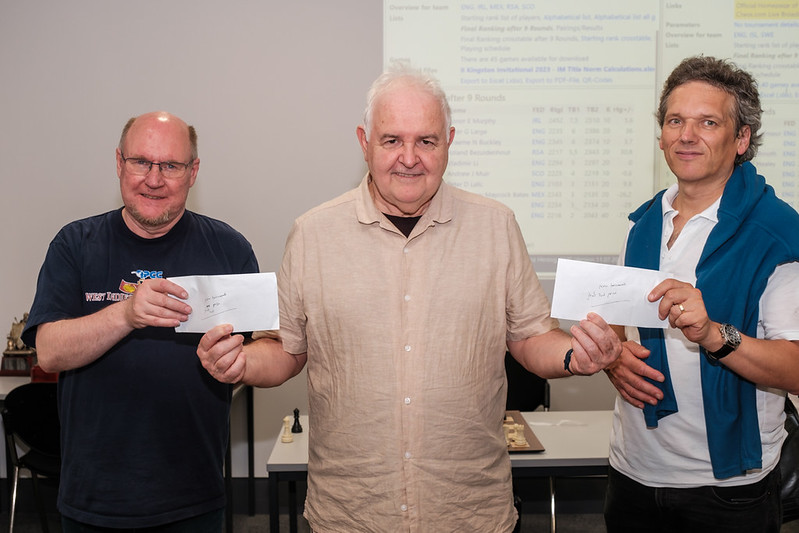
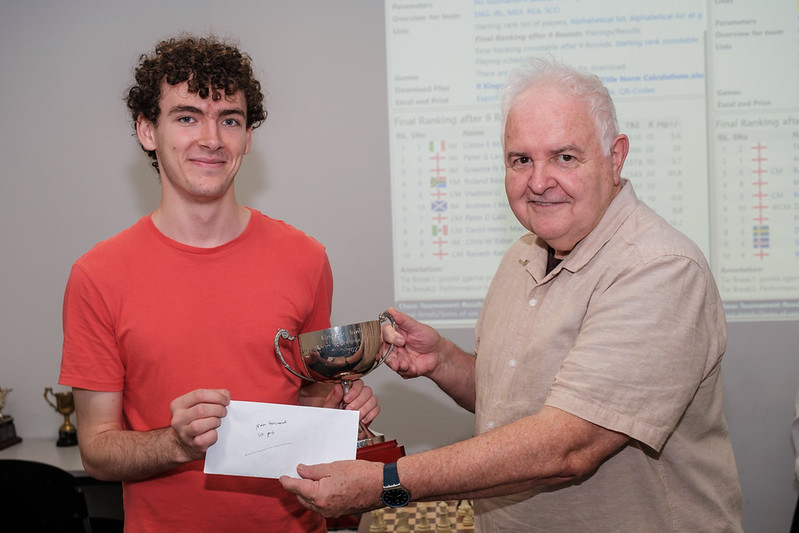
IM norm event – final ranking

IM norm event – final ranking crosstable

Fide-rated all-play-all – final ranking

Fide-rated all-play-all – final ranking crosstable

Postscript
Stephen Moss, Kingston Invitational organiser
I received this email from one of the players on the day after the tournament/congress/festival – I have yet to decide what the event actually is – ended: “Congratulations on another wonderful event, surely unique on the tournament calendar for its combination of fighting chess on the board and friendly atmosphere off it.” Now, I have no doubt there are other events which combine these qualities, but for me this remark from a player and person I admire made staging the Kingston Invitational worthwhile.
The event would not have been possible without Kingston University, which once again supplied an excellent venue, though why modern architects favour rooms with windows that do not open defeats me. The centrally controlled aircon was not quite up to the job on the muggy final day. It was, though, lovely to be playing in graduation week: so many happy graduates and their families taking photographs that will be on display for the rest of their lives. I fear I may be in quite a few of them.
Lance Leslie-Smith, Mark Hogarth and Jake Hung were on arbiter duty, and adroitly negotiated a number of tricky positions. Rob Hammond provided the live boards, which gave us international coverage on the major chess platforms. John Saunders performed brilliantly as photographer, daily reporter and games analyst – he will at some point award the best game prize in each section. John’s contribution – he was at the venue for 10 hours or more or day – was over and above the call of duty.
Thanks, too, to Kingston club members who came to watch, support and eat the cream and jam doughnuts which are the defining gastronomic characteristics of the event, in the way that pea soup is at Wijk-aan-Zee. If IM norms were awarded for doughnut eating, Kingston Chess Club would be a power in the land. I must single out chair Alan Scrimgour – not, I hasten to add, a doughnut-eater – for attending the Invitational so soon after playing for Scotland in a tough tournament in Poland, and president John Foley, not least for providing excellent nameplates for the players (in place of my inexpertly scribbled ones – John is a purist who likes to do things with decorum) and presenting the prizes.
What we will do next year for Kingston Invitational 3 is a riddle wrapped in an enigma, Just now, in my slightly mellow but exhausted state, I can see the attraction of a Glastonbury-style fallow year. But no doubt come 2024 the urge to do it all again will start to make itself felt. For the moment, sleep beckons.